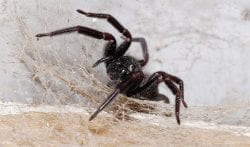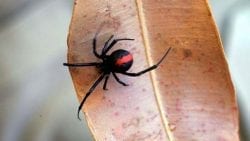Everything You Need to Know About Common Australian Spiders

According to the current Australian spider chart, there are over 4,000 species of arachnids calling the land down under home. We live alongside them every day, most of the time unknowingly, only reacting when their eight-legs come our way and set up camp in the spaces we use the most. When it comes to spider identification Australia as a nation seems to divide these insect assassins into dangerous and not dangerous. While some of the spiders on this list are certainly formidable and others poisonous, they’re all essential to our eco-system.
10 Types of Spiders We Encounter Every Day
Redback Spider
Appearance: The female sports the famous red racing stripe on its back, ranging from a solid line to spots or white lines. Males wear a combination of yellow and white markings and a few of either sex have nothing at all!
Distribution: Australia wide.
Size: Male spiders usually grow to around 5mm long, while females can measure in at 15mm long.
Habitat: Redbacks set up camp under rocks, in logs or under household fixtures like eaves, floorboards, flower pots and shelves.
Lifecycle: A female redback spider takes around 3 months to reach maturity. She can lay between 3 and 8 eggs sacs between spring and the beginning of winter each year, with each sac containing 300 eggs. If you’re wondering why you’re not overrun with redbacks, it’s all about quantity – many hatchlings do not survive thanks to droves of hungry siblings. Males live up to 7 months, while females stick around up to 3 years!
Food: Redbacks are carnivores, with a diet ranging from small insects right up to small mice, snakes and frogs.
Danger rating: High. A redback bite is potentially fatal.
White Tail Spider

Appearance: The white tail spider is a little chunkier than you’d first expect, featuring defined white spots at both the top and tail of a grey abdomen. Each leg is a muted brown attached to a long oval body.
Distribution: There are two types of white tail spiders, although the differences are microscopic. Lampona cylindrata is common in south-east Queensland, New South Wales, Victoria, South Australia, Tasmania and Western Australia while Lampona murina is exclusively based on the eastern seaboard, from north-east Queensland to Victoria.
Size: Girls measure up to 18mm long while guys are a bit smaller, reaching up to 12mm in body length.
Habitat: Garden beds, underneath rocks, bark and leaves, and they love to sneak into drying laundry. They’re night owls too, so expect to see them during the wee hours of the morning.
Lifecycle:
Food: White tail spiders love chowing down on other spiders, particularly black house spiders, red backs and daddy long legs.
Danger rating: High. White tail spider bites may cause human skin to eat away.
Huntsman Spider

Appearance: The big, hairy huntsman can be brown, black or grey with a few combinations in-between. There are over 1000 species of huntsman in Australia, so appearances are understandably varied!
Distribution: Australia wide
Size: These guys have quite an impressive leg-span, reaching over 160mm. Although this makes them look fearsome, they’re actually quite timid. Have a closer look at their legs – two back pairs are smaller than the rest, opening up their range of motion – they can walk forwards and sideways!
Habitat: Tree trunks, garden stones and bedding, bricks walls or interior walls. Some squeeze to fit slight crevices.
Lifecycle: A female Huntsman is a protective anarchid, standing guard over 200 plus eggs contained in a flat, oval sac for around three weeks until they hatch. When it’s time, she helps her young out of their enclosure, staying with her newborns for many weeks. Huntsmans can live up to 2 years.
Food: The huntsman runs down insects, other spiders, small lizards and frogs for breakfast, lunch and dinner.
Danger rating: Low. A huntsman can deliver a nasty bite, but that’s all it can do.
Mouse Spider

Appearance: A close cousin of the Sydney funnel web and trapdoor spiders, the Mouse spider has a short, chunky body with big fang sheaths. Their colour ranges from dark brown to black. There are 10 species of mouse spider in Australia – all have a potentially threatening bite.
Distribution: Mouse spiders can be found on the eastern seaboard of Australia and into highland country.
Size: Mouse spiders range in size according to specimen, not sex, reaching up to 3cm.
Habitat: Like their relatives, the Trapdoor spider, Mouse spiders live in underground burrows with a door for privacy and security. These burrows can be 30cm long.
Lifecycle: Male mouse spiders reach maturity at 4 years old, beginning their search for a mate. The male dies shortly after coitus. The female spider builds a large chamber for an egg sac that holds roughly 60 eggs – these hatch over the hotter months and the young stay with Mum until autumn.
Food: Mouse spiders like to eat insects and small animals.
Danger rating: High. On par with the Sydney Funnel Web, if you suspect a mouse spider bite, dial 000 and get help as soon as possible.
Black House Spider

Appearance: The wily house spider has dark brown to black legs and a dark grey abdomen. You’ll occasionally observe a white dorsal pattern, although these markings aren’t always present.
Distribution: Southern and eastern Australia.
Size: Black house spiders reach up to 1.5cm long, not including leg span.
Habitat: Tree trunks, ledges, rock walls, buildings, window panes and spacious crevices. Keep an eye out for sheet-like webs – the female black house spider is continually upgrading her web, adding and repairing new sections as breakages occur.
Lifecycle: Black house spiders reach maturity over a 3 month period, usually in summer, living for up to 2 years. Females spiders weave several sacs full of eggs, staying with her babies until they hatch. The spiderlings disperse straight away.
Food: Insects.
Danger rating: High. Black house spiders don’t want to bite you, but once they do, it can be extremely painful, leading to nausea, vomiting and sweating. Skin lesions may also develop.
Orb Spider
Appearance: You may recognise these fellows from your garden. They range from reddish brown to grey with a triangular body – you may notice a leaf pattern on their backs.
Distribution: Common through the eastern and southern Aussie states.
Size: 1 to 2,5cm body length with a variable leg span.
Habitat: Orb weavers like to spread their net wide… literally. You’ll find them setting up their large webs between trees and shrubs to catch any insects flying by.
Lifecycle: The female finds a leaf she likes and attaches the cocoon. This is the end of her involvement. After hatching, spiderlings floats on the breeze with the help of tiny web silks (“ballooning”) until they land on a tree or shrub, beginning the cycle again. Orb spiders only live for 12 months.
Food: Any bug that happens to land in its web, usually beetles, flies and cicadas.
Danger Rating: Extremely low. They’re quite timid, but if pushed to bite, effects are minimal.
The Funnel Web Spider
Appearance: Funnel web spiders are large in size, ranging from a blue-black to brown or even a glossy plum colour.
Distribution: Funnel webs can be found in NSW, QLD, SA and Tasmania. The Sydney funnel web is found within a 100km radius of Sydney, NSW.
Size: Body length can vary, usually between 1 and 5cm.
Habitat: Funnel webs like humid, contained environments. Besides self-made burrows – complete with triplines to catch prey – they’ve also been known to live under rocks, logs or holes in barked trees.
Lifecycle: Male funnel webs die around 6-8 months after mating, reaching sexual maturity at 4 years old. Females reach maturity at 5 years, and continue to live and breed for many years after.
Food: Insects, lizards and frogs.
Danger Rating: Extremely high. The funnel web is an aggressive spider. They intimidate their prey by rearing up on their hind legs and flashing their sizeable fangs – if they bite, they do so repeatedly. If you’ve been bitten by a Sydney funnel web, dial 000 immediately.
Wolf Spider

Appearance: The wolf spider is a common site across Australia, with a thick body and long legs. Colours are dull, but patterns of grey, white, black and brown help them stand out. Distribution: Australia wide.
Size: 1-8 cm from head to tail.
Habitat: Wolf spiders aren’t fussy about where they live. They can be found in shrubs, trees, barked forests, coastal and inalnds areas, in addition to everyday gardens. You’ll find wolf spiders in shallow burrows.
Lifecycle: While a female wolf spider can live for many years, males only last 12 months. They’re one of the only spiders to carry their eggs, attaching the sac to their abdomens – once the spiderlings hatch, they climb up their mothers legs and hang out on her belly and back for safety.
Food: Wolf spiders enjoy a meal of crickets. ants, other spiders, grasshoppers and small bugs.
Danger Rating: Medium to high. In addition to swelling, pain and itching, wolf spider bites can be necrotic, leading the skin to eat away.
Australian Tarantula
Appearance: The Australian tarantula is a large, heavy spider, ranging from a deep brown to a pale tan colour. Many species have yet to be described.
Distribution: Coastal QLD and Darwin.
Size: 2.5 to 12.5cm, depending on the species.
Habitat: Females live in underground burrows – some can be up to 1m deep – while males and juveniles seek shelter under logs and large rocks.
Lifecycle: Males often die after mating season, reachings sexual maturity at 5 years. Females live up to 12 years, laying around 50 eggs per sac. While the extent of maternal care provided after hatching is largely unknown, there have been instances where a mother has caught and fed her spiderlings an insect.
Food: Australian tarantulas can eat birds, but usually prefer easier prey in the form of insects, lizards, frogs and other spiders.
Danger Rating: Medium. Aussie tarantulas aren’t naturally aggressive, but will bite if provoked. They tend to rear up on their hind legs and their fangs can deliver quite a painful experience, with severe illness and nausea following around 6-8 hours afterward. We recommend going to a hospital for treatment.
Daddy Long Legs Spider
Appearance: Found in every home, the daddy long legs is instantly recognisable for it’s extremely small body and long, thin legs.
Distribution: Australia wide. Introduced species from the UK.
Size: Body dimensions range from 0.6 to 23mm
Habitat: Daddy long legs love sharing your home, making their webs in dark, rarely used spaces where their handiwork won’t be destroyed.
Lifecycle: Like a few spiders on this list, male daddy long legs die after mating season, once they reach maturity at 12 months. Females can live up to 3 years.
Food: Daddy long legs spiders love chowing down on insects and other spiders.
Danger Rating: Low. Although urban legend says the daddy long legs lacks fangs big enough to pierce human skin, US television show Mythbusters proved the opposite was true. Rated as not harmful to humans, experts recommend that you seek medical attention if symptoms last longer than a few minutes.
Would you like to avoid running into any one of these crawling, creepy and sometimes scary creatures? Call Canberra Pest Control today and book a professional pest spray.
